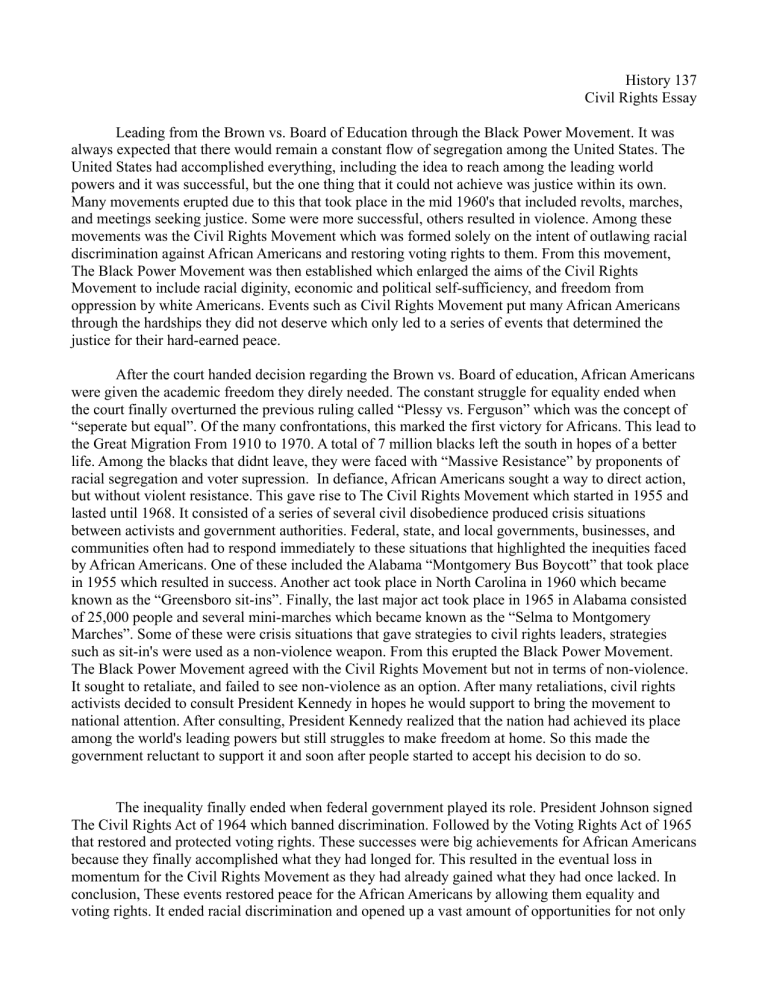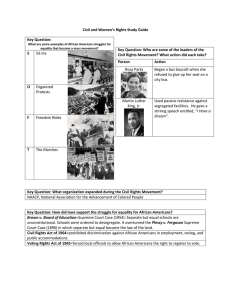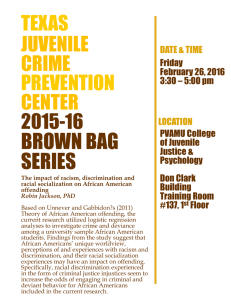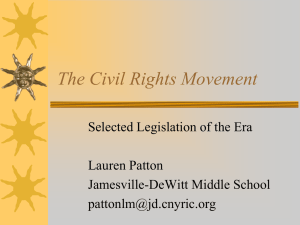Civil Rights & Black Power: From Brown v. Board to Black Power
advertisement

History 137 Civil Rights Essay Leading from the Brown vs. Board of Education through the Black Power Movement. It was always expected that there would remain a constant flow of segregation among the United States. The United States had accomplished everything, including the idea to reach among the leading world powers and it was successful, but the one thing that it could not achieve was justice within its own. Many movements erupted due to this that took place in the mid 1960's that included revolts, marches, and meetings seeking justice. Some were more successful, others resulted in violence. Among these movements was the Civil Rights Movement which was formed solely on the intent of outlawing racial discrimination against African Americans and restoring voting rights to them. From this movement, The Black Power Movement was then established which enlarged the aims of the Civil Rights Movement to include racial diginity, economic and political self-sufficiency, and freedom from oppression by white Americans. Events such as Civil Rights Movement put many African Americans through the hardships they did not deserve which only led to a series of events that determined the justice for their hard-earned peace. After the court handed decision regarding the Brown vs. Board of education, African Americans were given the academic freedom they direly needed. The constant struggle for equality ended when the court finally overturned the previous ruling called “Plessy vs. Ferguson” which was the concept of “seperate but equal”. Of the many confrontations, this marked the first victory for Africans. This lead to the Great Migration From 1910 to 1970. A total of 7 million blacks left the south in hopes of a better life. Among the blacks that didnt leave, they were faced with “Massive Resistance” by proponents of racial segregation and voter supression. In defiance, African Americans sought a way to direct action, but without violent resistance. This gave rise to The Civil Rights Movement which started in 1955 and lasted until 1968. It consisted of a series of several civil disobedience produced crisis situations between activists and government authorities. Federal, state, and local governments, businesses, and communities often had to respond immediately to these situations that highlighted the inequities faced by African Americans. One of these included the Alabama “Montgomery Bus Boycott” that took place in 1955 which resulted in success. Another act took place in North Carolina in 1960 which became known as the “Greensboro sit-ins”. Finally, the last major act took place in 1965 in Alabama consisted of 25,000 people and several mini-marches which became known as the “Selma to Montgomery Marches”. Some of these were crisis situations that gave strategies to civil rights leaders, strategies such as sit-in's were used as a non-violence weapon. From this erupted the Black Power Movement. The Black Power Movement agreed with the Civil Rights Movement but not in terms of non-violence. It sought to retaliate, and failed to see non-violence as an option. After many retaliations, civil rights activists decided to consult President Kennedy in hopes he would support to bring the movement to national attention. After consulting, President Kennedy realized that the nation had achieved its place among the world's leading powers but still struggles to make freedom at home. So this made the government reluctant to support it and soon after people started to accept his decision to do so. The inequality finally ended when federal government played its role. President Johnson signed The Civil Rights Act of 1964 which banned discrimination. Followed by the Voting Rights Act of 1965 that restored and protected voting rights. These successes were big achievements for African Americans because they finally accomplished what they had longed for. This resulted in the eventual loss in momentum for the Civil Rights Movement as they had already gained what they had once lacked. In conclusion, These events restored peace for the African Americans by allowing them equality and voting rights. It ended racial discrimination and opened up a vast amount of opportunities for not only African Americans that resided, but the immigrants that migrated from other countries that were also automatically a part of this category.





